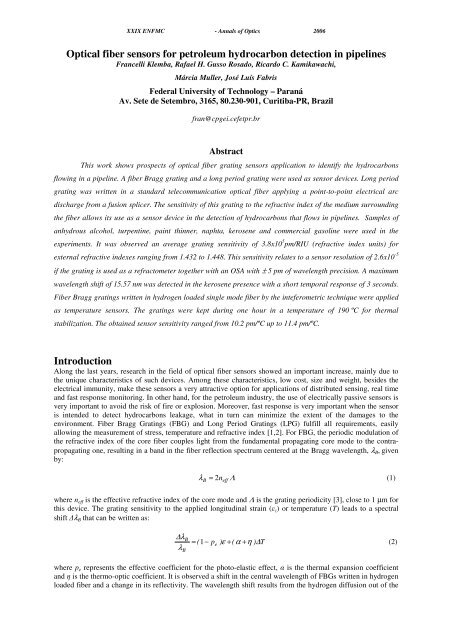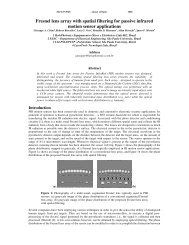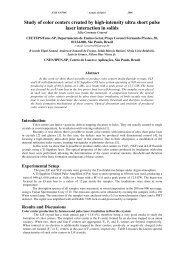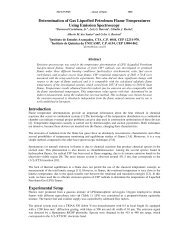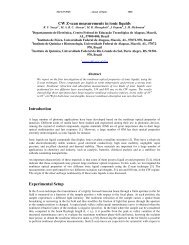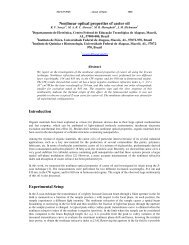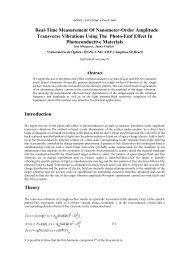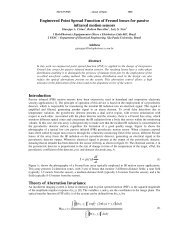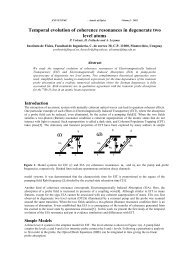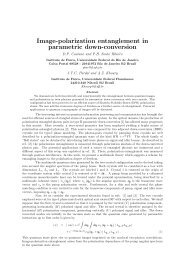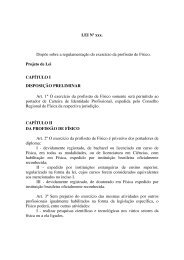Optical fiber sensors for petroleum hydrocarbon detection in pipelines
Optical fiber sensors for petroleum hydrocarbon detection in pipelines
Optical fiber sensors for petroleum hydrocarbon detection in pipelines
You also want an ePaper? Increase the reach of your titles
YUMPU automatically turns print PDFs into web optimized ePapers that Google loves.
XXIX ENFMC - Annals of Optics 2006<br />
<strong>Optical</strong> <strong>fiber</strong> <strong>sensors</strong> <strong>for</strong> <strong>petroleum</strong> <strong>hydrocarbon</strong> <strong>detection</strong> <strong>in</strong> pipel<strong>in</strong>es<br />
Francelli Klemba, Rafael H. Gusso Rosado, Ricardo C. Kamikawachi,<br />
Márcia Muller, José Luís Fabris<br />
Federal University of Technology – Paraná<br />
Av. Sete de Setembro, 3165, 80.230-901, Curitiba-PR, Brazil<br />
fran@cpgei.cefetpr.br<br />
Abstract<br />
This work shows prospects of optical <strong>fiber</strong> grat<strong>in</strong>g <strong>sensors</strong> application to identify the <strong>hydrocarbon</strong>s<br />
flow<strong>in</strong>g <strong>in</strong> a pipel<strong>in</strong>e. A <strong>fiber</strong> Bragg grat<strong>in</strong>g and a long period grat<strong>in</strong>g were used as sensor devices. Long period<br />
grat<strong>in</strong>g was written <strong>in</strong> a standard telecommunication optical <strong>fiber</strong> apply<strong>in</strong>g a po<strong>in</strong>t-to-po<strong>in</strong>t electrical arc<br />
discharge from a fusion splicer. The sensitivity of this grat<strong>in</strong>g to the refractive <strong>in</strong>dex of the medium surround<strong>in</strong>g<br />
the <strong>fiber</strong> allows its use as a sensor device <strong>in</strong> the <strong>detection</strong> of <strong>hydrocarbon</strong>s that flows <strong>in</strong> pipel<strong>in</strong>es. Samples of<br />
anhydrous alcohol, turpent<strong>in</strong>e, pa<strong>in</strong>t th<strong>in</strong>ner, naphta, kerosene and commercial gasol<strong>in</strong>e were used <strong>in</strong> the<br />
experiments. It was observed an average grat<strong>in</strong>g sensitivity of 3.8x10 5 pm/RIU (refractive <strong>in</strong>dex units) <strong>for</strong><br />
external refractive <strong>in</strong>dexes rang<strong>in</strong>g from 1.432 to 1.448. This sensitivity relates to a sensor resolution of 2.6x10 -5<br />
if the grat<strong>in</strong>g is used as a refractometer together with an OSA with ± 5 pm of wavelength precision. A maximum<br />
wavelength shift of 15.57 nm was detected <strong>in</strong> the kerosene presence with a short temporal response of 3 seconds.<br />
Fiber Bragg grat<strong>in</strong>gs written <strong>in</strong> hydrogen loaded s<strong>in</strong>gle mode <strong>fiber</strong> by the <strong>in</strong>teferometric technique were applied<br />
as temperature <strong>sensors</strong>. The grat<strong>in</strong>gs were kept dur<strong>in</strong>g one hour <strong>in</strong> a temperature of 190 ºC <strong>for</strong> thermal<br />
stabilization. The obta<strong>in</strong>ed sensor sensitivity ranged from 10.2 pm/ºC up to 11.4 pm/ºC.<br />
Introduction<br />
Along the last years, research <strong>in</strong> the field of optical <strong>fiber</strong> <strong>sensors</strong> showed an important <strong>in</strong>crease, ma<strong>in</strong>ly due to<br />
the unique characteristics of such devices. Among these characteristics, low cost, size and weight, besides the<br />
electrical immunity, make these <strong>sensors</strong> a very attractive option <strong>for</strong> applications of distributed sens<strong>in</strong>g, real time<br />
and fast response monitor<strong>in</strong>g. In other hand, <strong>for</strong> the <strong>petroleum</strong> <strong>in</strong>dustry, the use of electrically passive <strong>sensors</strong> is<br />
very important to avoid the risk of fire or explosion. Moreover, fast response is very important when the sensor<br />
is <strong>in</strong>tended to detect <strong>hydrocarbon</strong>s leakage, what <strong>in</strong> turn can m<strong>in</strong>imize the extent of the damages to the<br />
environment. Fiber Bragg Grat<strong>in</strong>gs (FBG) and Long Period Grat<strong>in</strong>gs (LPG) fulfill all requirements, easily<br />
allow<strong>in</strong>g the measurement of stress, temperature and refractive <strong>in</strong>dex [1,2]. For FBG, the periodic modulation of<br />
the refractive <strong>in</strong>dex of the core <strong>fiber</strong> couples light from the fundamental propagat<strong>in</strong>g core mode to the contrapropagat<strong>in</strong>g<br />
one, result<strong>in</strong>g <strong>in</strong> a band <strong>in</strong> the <strong>fiber</strong> reflection spectrum centered at the Bragg wavelength, λ B , given<br />
by:<br />
λ = 2n<br />
Λ<br />
(1)<br />
B<br />
eff<br />
where n eff is the effective refractive <strong>in</strong>dex of the core mode and Λ is the grat<strong>in</strong>g periodicity [3], close to 1 µm <strong>for</strong><br />
this device. The grat<strong>in</strong>g sensitivity to the applied longitud<strong>in</strong>al stra<strong>in</strong> ( z ) or temperature (T) leads to a spectral<br />
shift λ B that can be written as:<br />
∆λB<br />
λ<br />
B<br />
= 1 − p ) ε + ( α + η ) ∆T<br />
(2)<br />
( e<br />
where p e represents the effective coefficient <strong>for</strong> the photo-elastic effect, is the thermal expansion coefficient<br />
and is the thermo-optic coefficient. It is observed a shift <strong>in</strong> the central wavelength of FBGs written <strong>in</strong> hydrogen<br />
loaded <strong>fiber</strong> and a change <strong>in</strong> its reflectivity. The wavelength shift results from the hydrogen diffusion out of the
XXIX ENFMC - Annals of Optics 2006<br />
<strong>fiber</strong> that reduces the effective refractive <strong>in</strong>dex n eff (see eq. 1). The grat<strong>in</strong>g reflectivity given by eq. (3) is<br />
dependent on the effective refractive <strong>in</strong>dex n eff, as well as the <strong>in</strong>dex modulation ∆n [4].<br />
<br />
2<br />
πL∆n<br />
R = tanh <br />
(3)<br />
<br />
2Λn eff <br />
In this equation, L is the grat<strong>in</strong>g length. For grat<strong>in</strong>g periodicities of hundreds of micrometers, the device is called<br />
an LPG. In this case, the grat<strong>in</strong>g couples light from the fundamental core mode to the cladd<strong>in</strong>g modes, lead<strong>in</strong>g<br />
to several dips <strong>in</strong> the <strong>fiber</strong> transmission spectrum given by:<br />
<br />
m<br />
m<br />
= ( n − n )<br />
(4)<br />
co<br />
where λ m is the central resonance wavelength of the m th cladd<strong>in</strong>g mode, n co is the effective refractive <strong>in</strong>dex of the<br />
core mode, n is the effective refractive <strong>in</strong>dex of the m th cladd<strong>in</strong>g mode and Λ is the grat<strong>in</strong>g periodicity. As the<br />
m<br />
cl<br />
m<br />
effective refractive <strong>in</strong>dex n cl depends on the refractive <strong>in</strong>dex of the <strong>fiber</strong> surround<strong>in</strong>gs, the device can be used to<br />
identify de external medium. Spir<strong>in</strong> et al [5] presented a polymer-coated FBG-based sensor to be used <strong>in</strong> the<br />
<strong>detection</strong> of <strong>hydrocarbon</strong> leakage, result<strong>in</strong>g <strong>in</strong> a sensor with response time of 20 m<strong>in</strong>utes. Kamikawachi et al [6]<br />
showed the us<strong>in</strong>g of a LPG to monitor <strong>hydrocarbon</strong>s leakage <strong>in</strong> water environment. In that work, it was shown<br />
the need <strong>for</strong> a temperature monitor<strong>in</strong>g of the external medium to avoid a mis<strong>in</strong>terpretation of the results due to<br />
the crossed grat<strong>in</strong>g sensitivity to temperature (70 pm/°C) and refractive <strong>in</strong>dex. In this work, FBG and LPG were<br />
produced and characterized as temperature and refractive <strong>in</strong>dex <strong>sensors</strong> of the <strong>fiber</strong> surround<strong>in</strong>gs, respectively.<br />
The LPG sensor was successfully employed to identify several <strong>hydrocarbon</strong>s samples flow<strong>in</strong>g under controlled<br />
conditions. Moreover, a method <strong>for</strong> FBG defects stabilization was employed.<br />
Experimental Setup<br />
The LPG (Λ= 600 µm, 60 <strong>in</strong>teraction po<strong>in</strong>ts) was recorded <strong>in</strong> a s<strong>in</strong>gle mode <strong>fiber</strong> us<strong>in</strong>g the po<strong>in</strong>t-to-po<strong>in</strong>t<br />
electrical arc discharge method with a fusion splicer (Siemens, S46999-M7A3), <strong>in</strong> a technique similar to<br />
described by [7]. The grat<strong>in</strong>g sensitivity characterization <strong>for</strong> changes <strong>in</strong> the refractive <strong>in</strong>dex of the surround<strong>in</strong>gs<br />
was carried out allow<strong>in</strong>g the LPG to be <strong>in</strong> contact with the fluid under analysis <strong>in</strong> a plastic pipe. To avoid<br />
<strong>in</strong>fluence of curvature, stress and temperature <strong>in</strong> the grat<strong>in</strong>g response, the LPG was glued on the <strong>in</strong>ternal pipe<br />
wall, and the temperature was monitored to be constant with<strong>in</strong> 19.5 °C ± 1 °C. After the <strong>in</strong>sertion of the desired<br />
sample, the flow was <strong>in</strong>terrupted and the grat<strong>in</strong>g spectrum was measured under static conditions. As the<br />
measurement was completed, the fluid was dra<strong>in</strong>ed, a new sample was <strong>in</strong>jected and the process was repeated. A<br />
LED (Superlum, Pilot 2) was used as a light source, and the grat<strong>in</strong>g spectrum was analyzed with an optical<br />
spectrum analyzer – OSA (Anritsu, MS9710B, 0.1 nm resolution, ± 5 pm of wavelength stability). Samples of<br />
alcohol, turpent<strong>in</strong>e, th<strong>in</strong>ner, naphtha, kerosene and gasol<strong>in</strong>e were used <strong>in</strong> the experiment. FBG was also<br />
produced <strong>in</strong> a s<strong>in</strong>gle mode <strong>fiber</strong> loaded with hydrogen, dur<strong>in</strong>g 2 weeks at 150 psi, to <strong>in</strong>crease the <strong>fiber</strong><br />
photosensitivity. The writ<strong>in</strong>g setup used a phase mask <strong>in</strong>terferometer with two mirrors computer controlled, with<br />
an angular resolution of 0.001 degrees, and a 266 nm Nd-YAG laser (NewWave, Tempest 20). The thermal<br />
characterization of the grat<strong>in</strong>gs was carried out with the aid of a thermopar and a thermoelement Peltier <strong>in</strong> three<br />
heat<strong>in</strong>g and cool<strong>in</strong>g cycles. The thermal treatment <strong>for</strong> the grat<strong>in</strong>g stabilization was done <strong>in</strong> an electrical oven.<br />
Results and Discussion<br />
Results of the LPG sensitivity to the external medium refractive <strong>in</strong>dex are presented <strong>in</strong> Figure 1, <strong>for</strong> two<br />
complete cycles. Each cycle corresponds to the grat<strong>in</strong>g characterization <strong>for</strong> alcohol, turpent<strong>in</strong>e, th<strong>in</strong>ner, naphtha,<br />
kerosene and gasol<strong>in</strong>e, <strong>in</strong> this sequence. The wavelength shift δλ of the grat<strong>in</strong>g resonance was measured<br />
regard<strong>in</strong>g to the grat<strong>in</strong>g resonance <strong>in</strong> the air. Dur<strong>in</strong>g the second cycle, the resonance wavelengths nearly recover<br />
the wavelengths of the last cycle. The small differences detected are with<strong>in</strong> the OSA wavelength stability. The<br />
temporal response of the sensor (close to 3 seconds) is ma<strong>in</strong>ly determ<strong>in</strong>ed by the data acquisition time of the<br />
equipment. The wavelength shifts ranged from –3.82 nm to –15.57 nm (<strong>for</strong> alcohol and kerosene, respectively),<br />
correspond<strong>in</strong>g to the samples with refractive <strong>in</strong>dexes <strong>in</strong> the lower and higher sensitivity zones of the grat<strong>in</strong>g.<br />
This sensitivity is showed <strong>in</strong> Figure 2, where the wavelength shift δλ of the grat<strong>in</strong>g resonance is displayed as a<br />
function of the sample refractive <strong>in</strong>dex. The closer the refractive <strong>in</strong>dex to the cladd<strong>in</strong>g one (1.458), the higher the<br />
wavelength shift and consequently the grat<strong>in</strong>g sensitivity. In the range of refractive <strong>in</strong>dexes between 1.432<br />
(th<strong>in</strong>ner) and 1.488 (kerosene), which corresponds to the higher sensitivity zone, the average grat<strong>in</strong>g sensitivity<br />
was 3.8x10 5 pm/RIU (refractive <strong>in</strong>dex units).<br />
cl
XXIX ENFMC - Annals of Optics 2006<br />
0<br />
-5<br />
1<br />
4<br />
6<br />
1<br />
4<br />
6<br />
δλ(nm)<br />
-10<br />
2<br />
3<br />
2<br />
3<br />
-15<br />
5<br />
5<br />
-20<br />
0 500 1000 1500 2000 2500<br />
TIME (s)<br />
Figure 1: Wavelength shift δλ <strong>for</strong> the used LPG along the temporal cycles, when the<br />
grat<strong>in</strong>g is <strong>in</strong> contact with alcohol (1), turpent<strong>in</strong>e (2), th<strong>in</strong>ner (3), naphtha (4), kerosene (5)<br />
and gasol<strong>in</strong>e (6).<br />
-4<br />
δλ (nm)<br />
-6<br />
-8<br />
-10<br />
-12<br />
-14<br />
ALCOHOL<br />
NAPHTA<br />
GASOLINE<br />
THINNER<br />
TURPENTINE<br />
KEROSENE<br />
-16<br />
1.36 1.38 1.40 1.42 1.44<br />
REFRACTIVE INDEX<br />
Figure 2: Wavelength shift δλ <strong>for</strong> the used LPG as a function of the sample refractive<br />
<strong>in</strong>dex.<br />
For the produced FBG, the thermal behavior showed a hysteresis <strong>in</strong> the range of temperatures from 7 ° C to<br />
60 °C. This hysteresis is characterized by small shifts <strong>in</strong> the Bragg wavelength (< 40 pm) towards lower<br />
wavelengths <strong>for</strong> consecutive heat<strong>in</strong>g and cool<strong>in</strong>g cycles, what <strong>in</strong> turn can lead to a non-correct temperature<br />
determ<strong>in</strong>ation when the device is used as a thermometer. To m<strong>in</strong>imize this behavior, the grat<strong>in</strong>gs were kept<br />
under 190 °C dur<strong>in</strong>g one hour; after this time, the grat<strong>in</strong>g resonance presented a shift of 0.435 nm towards lower<br />
wavelengths (Figure 3a), besides a small decrease of 0.86 dB <strong>in</strong> the reflectivity (Figure 3b).<br />
(a)<br />
0.0<br />
(b)<br />
20.6<br />
δλ (nm)<br />
-0.1<br />
-0.2<br />
-0.3<br />
-0.4<br />
REFLECTIVITY(dB)<br />
20.4<br />
20.2<br />
20.0<br />
19.8<br />
0 10 20 30 40 50 60<br />
TIME (m<strong>in</strong>)<br />
0 10 20 30 40 50 60<br />
TIME (m<strong>in</strong>)<br />
Figure 3: FBG (a) wavelength shift δλ and (b) grat<strong>in</strong>g reflectivity along the time, while the<br />
grat<strong>in</strong>g was kept at 190 °C.
XXIX ENFMC - Annals of Optics 2006<br />
These parameters presented a fast decrease dur<strong>in</strong>g the first 30-40 m<strong>in</strong>utes of the thermal treatment, and a<br />
tendency to stabilize <strong>in</strong> the rema<strong>in</strong><strong>in</strong>g time. After the treatment, the grat<strong>in</strong>gs nor presented the early observed<br />
hysteresis. The thermal grat<strong>in</strong>g sensitivity was <strong>in</strong> the range from 10.2 pm/°C to 11.4 pm/°C.<br />
Conclusions<br />
The results presented <strong>in</strong> this work show that the LPG based sensor can be used to identify the <strong>hydrocarbon</strong>s<br />
flow<strong>in</strong>g <strong>in</strong> a pipel<strong>in</strong>e, with an average sensitivity of 3.8x10 5 pm/RIU <strong>for</strong> samples with refractive <strong>in</strong>dexes rang<strong>in</strong>g<br />
from 1.432 and 1.448. This sensitivity relates to a sensor resolution of 2.6x10 -5 if the grat<strong>in</strong>g is used as a<br />
refractometer together with an OSA with ± 5 pm of wavelength precision. Even <strong>in</strong> the lower sensitivity zone, the<br />
smallest wavelength shift measured (δλ= 3.824 nm <strong>for</strong> alcohol) can be easily detected by the <strong>in</strong>strument, as <strong>in</strong><br />
this zone the grat<strong>in</strong>g sensitivity was 4.5x10 4 pm/RIU, correspond<strong>in</strong>g to a resolution of 2.2x10 -4 <strong>for</strong> a refractive<br />
<strong>in</strong>dex measurement. The wavelength reproducibility <strong>for</strong> a given fluid <strong>in</strong> different cycles of the sample<br />
identification shows the sensor reliability. The very fast sensor response time (~3 seconds) makes it adequate <strong>for</strong><br />
many applications, like leakage monitor<strong>in</strong>g or fluid identification <strong>in</strong> pipel<strong>in</strong>es. The LPG temperature sensitivity<br />
can be compensated with the use of a FBG to measure this parameter. One advantage of us<strong>in</strong>g an FBG<br />
temperature sensor is the possibility of multiplex<strong>in</strong>g it <strong>in</strong> the same <strong>fiber</strong> l<strong>in</strong>k where the LPG is <strong>in</strong>stalled.<br />
However, this FBG must be stabilized be<strong>for</strong>e its use by means of the thermal treatment to assure a good<br />
per<strong>for</strong>mance of the sensor. The effects observed <strong>in</strong> Figure 3 can be associated with the presence of hydrogen <strong>in</strong><br />
the <strong>fiber</strong>s, previously <strong>in</strong>troduced to <strong>in</strong>crease the photo-<strong>in</strong>duced changes <strong>in</strong> the core <strong>fiber</strong> refractive <strong>in</strong>dex dur<strong>in</strong>g<br />
the grat<strong>in</strong>g production. The shift <strong>in</strong> the resonance dip to lower wavelengths while the grat<strong>in</strong>g is under high<br />
temperature leads to a decrease <strong>in</strong> the n eff of the core <strong>fiber</strong> due to the diffusion of loaded hydrogen out of the <strong>fiber</strong><br />
(see equation 1). This decrease <strong>in</strong> the n eff also contributes to the <strong>in</strong>crease <strong>in</strong> the grat<strong>in</strong>g reflectivity. However, the<br />
thermal structural relaxation of the defects reduces the <strong>in</strong>dex modulation ∆n, what contributes to decrease the<br />
grat<strong>in</strong>g reflectivity (see equation 3). The comb<strong>in</strong>ed effect is responsible by the observed decrease <strong>in</strong> the grat<strong>in</strong>g<br />
reflectivity dur<strong>in</strong>g the thermal treatment [8, 4]. It must be emphasized that the grat<strong>in</strong>g is stabilized <strong>for</strong> operation<br />
<strong>in</strong> temperatures below the temperature of the thermal treatment.<br />
Acknowledgements<br />
The authors thank the f<strong>in</strong>ancial support granted by Fundação Araucária, CAPES, CNPq and Agência<br />
Nacional do Petróleo (PRH-ANP/MCT, PRH10-CEFET-PR).<br />
References<br />
[1] PATRICK, H. J., WILLIANS, G. M., KERSEY, A. D., PEDRAZZANI, J. R., VENGSARKAR, A.M.<br />
Hybrid Fiber Bragg Grat<strong>in</strong>g / Long Period Fiber Grat<strong>in</strong>g Sensor <strong>for</strong> Stra<strong>in</strong> / Temperature Discrim<strong>in</strong>ation.<br />
IEEE Photonics Technology Letters, v. 8, 1223- 1225, 1996.<br />
[2] PATRICK, H. J., KERSEY, A. D., BUCHOLTZ, M. K., EWING, K. J., JUDKINS, J. B.,<br />
VENGSARKAR, A.M. Chemical Sensor Based on Long Period Fiber Grat<strong>in</strong>g Response to Index of<br />
refraction. OSA Technical Digest Series, v. 11, p. 420- 421, 1997.None none none<br />
[3] HILL K. O. and MELTZ G. Fiber Bragg Grat<strong>in</strong>g Technology Fundamentals and Overview. Journal of<br />
Lightwave Technology, v. 15, n. 8, p. 1263-1276, 1997.<br />
[4] MASUDA, Y., NAKAMURA, M., KOMATSU, C., FUJITA, K., YAMAUCHI, M., KIMURA, M.,<br />
MIZUTANI, Y., KIMURA, S., SUZAKI, Y., YOCUSHI, T., NAKAGAWA, K., EJIMA, S. Wavelength<br />
Evolution of Fiber Bragg Grat<strong>in</strong>gs Fabricated From Hydrogen-Loaded <strong>Optical</strong> Fiber Dur<strong>in</strong>g Anneal<strong>in</strong>g.<br />
Journal of Lightwave Technology, v. 22, n. 3, p. 934-941, 2004.<br />
[5] SPIRIN, V. V., SHLYAGIN, M. G., MIRIDONOV, S. V., JIMÉNEZ, F. J. M., GUTIÉRREZ, R. M. L.<br />
Fiber Bragg Grat<strong>in</strong>g sensor <strong>for</strong> <strong>petroleum</strong> <strong>hydrocarbon</strong> leak <strong>detection</strong>. Optics and Lasers <strong>in</strong> Eng<strong>in</strong>eer<strong>in</strong>g, v.<br />
32, p. 497-503, 2000.<br />
[6] KAMIKAWACHI, R. C., POSSETTI, G. R. C., MÜLLER, M. FABRIS, J.L. <strong>Optical</strong> Sensor Based on <strong>fiber</strong><br />
grat<strong>in</strong>g <strong>for</strong> Hydrocarbon Detection <strong>in</strong> aquatic Environment. XXVII Encontro Nacional de Física da Matéria<br />
Condensada, v. 6, 2004.<br />
[7] KASHYAP, P. Fiber Bragg Grat<strong>in</strong>g, San Diego, Academic Press, 1999.<br />
[8] CANNING, J., SOMMER, K., ENGLUND, M. Fibre Grat<strong>in</strong>gs <strong>for</strong> high temperature sensor applications.<br />
Measurement Science and Technology, v. 12, p. 824-828, 2001.


